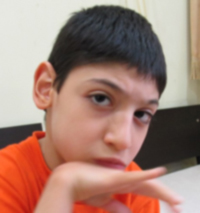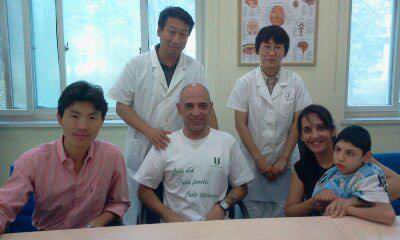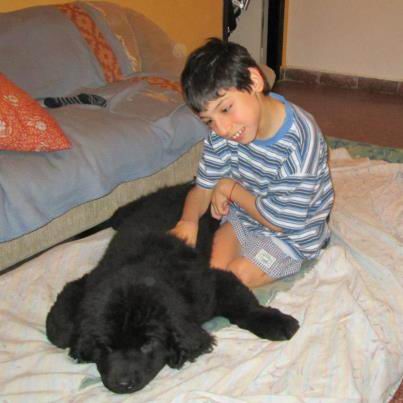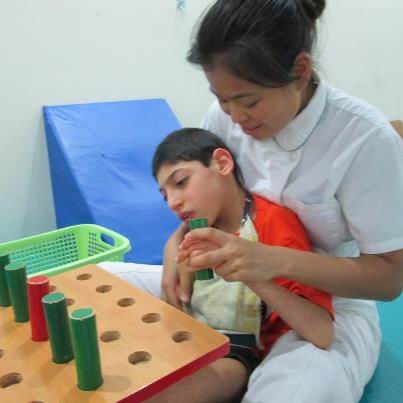Theo Bravo - Sequelae of brain injury (Argentina) Posted on October 15, 2012
Name: Theo Bravo 
Sex: Male
Country: Argentina
Age: 9 years
Diagnosis: Sequelae of brain injury
Admission Date: August 15, 2012
Days Admitted to Hospital: 30
Before treatment:
Theo Bravo is a 9 year old boy. His mother received regular examinations before Theo Bravo was born. The examinations results were normal. The baby was a full-term normal delivery. The baby showed no abnormalities at birth. About 10 days later, he went into cardiac arrest and was in cardiac arrest for 14 minutes. After resuscitation, the heartbeat was restored, but he suffered from arrhythmia. He took some medication for treatment. The cardiac rhythm was restored to normal level when he was 2 years old. He stopped taking the medication when he was more than 2 years old. He was presented with motor function disorder, cognitive function delay and development delay after birth. Asyndesis. Theo started with speech rehabilitation and limbs function rehabilitation. And he received visual stimulus exercises when he was 4 years old. At present, the patient's right vision is better than the left eye's vision. He could hear sound and had response to the sound. He was unable to speak and was unable to communicate with others. He could only say "m""m". He was unable to control defecation and using paper diapers for a long time. His comprehension ability was poor and he could only understand simple words. He was unable to finish instructions and was unable to pay attention. He always sucks his fingers. He could drink liquids, but couldn't chew. His right hand could grasp toys, but the left hand had no grasp action. He could turn over in bed and could sit up slowly and stay in the sitting position. He was unable to stand or walk by himself. He couldn't take care of himself and couldn't dress or wash himself.
Admission PE:
The eye position was abnormal. He had strabismus. The oro-nasal showed no obvious abnormalities. The thorax was deformed and presented a pectus carinatum shape. The respiratory sounds in both lungs were clear with no signs of dry or moist rales. The heart sound was strong and the heart rhythm was regular. The heart rate was 102/min. There was no obvious murmur in the auscultatory valve areas. The abdomen was sinking and soft, with no masses found. The liver and spleen were not palpable under the rib. There were joint deformities of bilateral wrists, knees and ankles.
Nervous System Examination:
The patient was alert. He had asyndesis. He couldn't cooperate with the examination of memory, calculation or orientation. Both pupils were equal in size, the diameter was 3.0mms. Both pupils reacted normally to light stimulus. The co-ordination of both eyes was poor. There was no nystagmus. The patient couldn't cooperate with the vision or visual field examination. The patient's right vision was better than the left. His right eye could stare at the object, but the left side couldn't do that. The nasolabial sulcus was equal in depth. He couldn't cooperate with the examination to show teeth or tongue out. The movement of the neck was flexible. The movement of four limbs was flexible and the right side was more flexible than the left side. He had hyperactivity. The muscle tone of both upper limbs was normal. The muscle tone of both lower limbs was increased. He couldn't cooperate with the examination of muscle strength. His right hand could grasp and could hold a light object. The left hand couldn't grasp. He could turn over by himself. He could sit up and maintain a sitting position. He could bend and stretch lower limbs. He couldn't stand or walk by himself. The abdominal reflexes were normal. The tendon reflex of both upper limbs was weakened. The tendon reflex of the lower limbs was negative. Bilateral palm jaw reflex was negative. Bilateral Hoffmann sign was negative, bilateral Babinski sign was negative. The Pussep sign was negative. The Chaddock sign was negative. He couldn't cooperate with the examination of deep, shallow sensation and coordinate movement.
Treatment:
We initially gave Theo Bravo a complete examination, and according to the patient's medical history, symptoms and sign, he was diagnosed with sequelae of brain injury. He received treatment to improve the blood circulation, nourishment for the neurons and expand blood vessels. This was accompanied with sports, language and cognitive function training.
Post-treatment:
The patient's emotion is better than before. The condition of irritability is less than before. The muscle strength and control force of the vertebral column is better. He could turn his head and chase an object.
The patient's family member email to us:
2012-11-18
Dear Doctor,
Theo have breakfast, lunch, snack, dinner at the usual hours.
The portions are plentiful, as for an adult.
1 kg increase in weight over.
Regarding the changes and improvements:
stays straighter sit in the chair, their position is a bit more symmetrical , his ribs are almost at the same height. He also more connected with the environment ... claims with someone's presence, not alone. yes supports the dimly lit rooms. He Is oriented from where sounds are coming from and try to locate visually. Have faster response to any movement that wishes to, and something that had not happened before, scares or startle at loud sound like thunder or fireworks. I think all the changes are good.
thank you very much. best regards
Fabiana Caraballo



The second round treatment:
Name: Theo Bravo
Sex: Male
Country: Argentina
Age: 10 years
Diagnosis: Sequelae of brain injury
Admission Date: October 3, 2013
Days Admitted to Hospital: 26
Before treatment:
The patient has better emotion after the treatment of last year. The muscle strength of vertebral column was stronger. The sitting position was better than before. He has better perception to surrounding. For further therapy, he came to our hospital for further treatment.
Admission PE:
Bp: 95/65mmHg; Br: 20/min, Hr: 76/min. Height: 115cm, weight: 18Kg. The skin and mucosa were normal, with no yellow staining or petechia. The eye position was abnormal. He had strabismus. The oro-nasal showed no obvious abnormalities. The thorax was deformed and presented a pectus carinatum shape. The respiratory sounds in both lungs were clear with no signs of dry or moist rales. The heart sound was strong and the heart rhythm was regular. The heart rate was 76/min. There was no obvious murmur in the auscultatory valve areas. The abdomen was sinking and soft, with no masses found. The liver and spleen were not palpable under the rib. There were joint deformities of bilateral wrists, knees and ankles. Spinal had mild scoliosis.
Nervous System Examination:
The patient was alert. He had asyndesis. He couldn't cooperate with the examination of memory, calculation or orientation. Both pupils were equal in size, the diameter was 3.0mms. Both pupils reacted normally to light stimulus. The co-ordination of both eyes was poor. There was no nystagmus. The patient couldn't cooperate with the vision or visual field examination. The patient's right vision was better than the left. His right eye could stare at bilateral object, but the left side was poor to do that. The nasolabial sulcus was equal in depth. He couldn't cooperate with the examination to show teeth or tongue out. The movement of the neck was flexible. The movement of four limbs was flexible and the right side was more flexible than left side. The muscle tone of both upper limbs was normal. The muscle tone of both lower limbs was increased. He couldn't cooperate with the examination of muscle strength. His right hand could grasp and could hold a light object. The left hand couldn't grasp. He could turn over by himself. He could sit up and maintain sitting position. He could bend and stretch lower limbs. He couldn't stand or walk by himself.The abdominal reflexes were normal. The tendon reflex of both upper limbs was weakened. The tendon reflex of the lower limbs was active. The sucking reflex was negative. Bilateral palm jaw reflex was positive. Bilateral Hoffmann sign was negative, bilateral Babinski sign was negative.The Pussep sign was negative. The Chaddock sign was negative. He couldn't cooperate with the examination of deep, shallow sensation and coordinate movement. There was no meningeal irritation sign.
Treatment:
The patient received treatment on October 3, 2013. The patient received nerve regeneration treatment and stem cell activating treatment. He received treatment to improve the blood circulation, nourishment for the neurons and expand blood vessels. This was accompanied with sports, language and cognitive function training.
Post-treatment:
The patient's emotion is better than before. The condition of irritability was less than before. He can cooperate with rehabilitation better than before. The muscle strength and control force of trunk is better. He could turn his head left side and right side to see the object behind him. He has better control of both upper limbs. The muscle strength of right hand is stronger than before. The action of right hand is more flexible. Left hand has grasp action and has action of forward push. The muscle tone of lower limbs is reduced than before. The muscle strength of both lower limbs has increased than before. He can finish the exercises of stand bed better. With some assistance, the patient can walk a few steps.
(Download the Windows Media Player Firefox Plugin if you are using Firefox browser.
To know more,Please read Using the Windows Media Player plugin with Firefox.)
